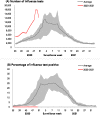National influenza mid-season report, 2020-2021
- PMID: 33679244
- PMCID: PMC7919779
- DOI: 10.14745/ccdr.v47i01a01
National influenza mid-season report, 2020-2021
Abstract
Canada's national influenza season typically starts in the latter half of November (week 47) and is defined as the week when at least 5% of influenza tests are positive and a minimum of 15 positive tests are observed. As of December 12, 2020 (week 50), the 2020-2021 influenza season had not begun. Only 47 laboratory-confirmed influenza detections were reported from August 23 to December 12, 2020; an unprecedentedly low number, despite higher than usual levels of influenza testing. Of this small number of detections, 64% were influenza A and 36% were influenza B. Influenza activity in Canada was at historically low levels compared with the previous five seasons. Provinces and territories reported no influenza-associated adult hospitalizations. Fewer than five hospitalizations were reported by the paediatric sentinel hospitalization network. With little influenza circulating, the National Microbiology Laboratory had not yet received samples of influenza viruses collected during the 2020-2021 season for strain characterization or antiviral resistance testing. The assessment of influenza vaccine effectiveness, typically available in mid-March, is expected to be similarly limited if low seasonal influenza circulation persists. Nevertheless, Canada's influenza surveillance system remains robust and has pivoted its syndromic, virologic and severe outcomes system components to support coronavirus disease 2019 (COVID-19) surveillance. Despite the COVID-19 pandemic, the threat of influenza epidemics and pandemics persists. It is imperative 1) to maintain surveillance of influenza, 2) to remain alert to unusual or unexpected events and 3) to be prepared to mitigate influenza epidemics when they resurge.
Keywords: H1N1; H3N2; influenza; influenza-like illness; outbreaks; pandemic preparedness; surveillance.
Conflict of interest statement
Competing interests: None.
Figures

References
-
- Public Health Agency of Canada. Weekly influenza reports. December 6, 2020 to December 12, 2020. Ottawa (ON): PHAC; 2020. https://www.canada.ca/en/public-health/services/diseases/flu-influenza/i...
-
- Public Health Agency of Canada. FluWatch report: March 29 to April 4, 2020 (week 14). Ottawa (ON): PHAC; 2020. https://www.canada.ca/en/public-health/services/publications/diseases-co...
-
- World Health Organization. Influenza Update No 382. Geneva (Switzerland): WHO; December 2020. https://www.who.int/publications/m/item/influenza-update-n-382
LinkOut - more resources
Full Text Sources
Other Literature Sources
Research Materials

